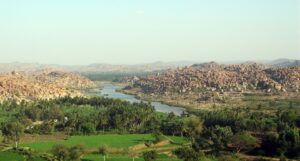
Facts and statistics about Hampi, display the beauty of this city that fated destruction, beyond repair.
Location of Hampi City
Located in the Southern parts of India, Hampi falls in the middle of Karnataka. The nearest airport to Hampi is 353 km in Bangalore. The nearest railway station is in Hospet.
Facts about its rich history
Hampi stands tall and steady similar to the Egyptian pyramids, tombs, and statues. They narrate an intense history of its existence.
One glance at the overlooking city and the person dives into an ocean of history. A history that screams its glory as well haunts us in ways that run a chill down the spine.
Hampi is not only for sightseeing and to satisfy the thirst of travelers. But it’s a zenith for historians and history lovers.
Let’s begin with a few historical facts about its rulers
Fact 1- Its history traces back to the Mauryan period, around 238 BCE. It’s the picture of historical India when Ashoka the mighty king, conquered almost the entire half of the Indian sub-continent.
Fact 2- From the on slot of the 5th century till the breakdown of the 13th century, several of the rulers ruled over the region.
The data includes a list of ruling dynasties- The Chalukyas of Badami, The Rashtrakutas, The Chalukyas of Kalyan, and the Hosalas.
Fact 3- However, during the phase of Hindu ruling dynasties, Muslim invaders gained control in the North of India.
Fact 4- Vijayanagara Empire came into existence with the collaboration of southern kings. With a motive to establish roads for marketing purposes.
Fact 5- Hence the capital shifted to Hampi thus evolving its phase into its golden era.
India’s richest city
Hampi was the capital of the Vijayanagara Empire. Indeed, we are talking about the same Vijayanagara that walked with us in our childhood, in the form of king Krishnadevraya and Tenali Raman.
India is a country known for its cotton and spices in the entire Middle East and Europe.
At the forefront of the 16th century, Hampi traded with Persia and Portugal. Thus a heap of cotton and spices made their way out of Hampi during this time.
Hampi was the most prosperous city after Beijing. That gives it a position on the worldwide level!
The statistics state that it held a population of 500,000 people who once called it their home.
How big is it
Hampi, known for its iconic chariot is certainly vastly more than that.
Hampi includes a total number of 1600 breathtaking monuments.
Distinguished from being really huge with a large area of 41 square km.
Modern cities include temples that you could count on with one hand but Hampi includes 1600 different monuments. The monuments themselves surround a small village in between.
This explains how huge it is!
The man behind the discovery of Hampi
Colin Mackenzie.
An official in the East India Company is also an engineer and a collector of antiques. Colin discovered the ruins of Hampi in 1800.
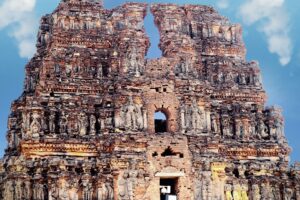
Ruins of Hampi
The ruins of Hampi are collectively called the ‘Hampi group of monuments'.
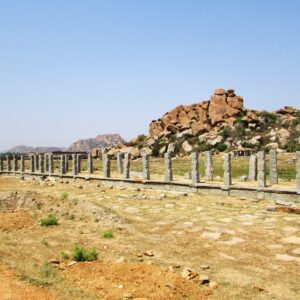
Hampi Bazar
Hampi as an International Trade Center
Facts and statistics about Hampi state that it was one of the biggest international trade centers that spread over 4000 hectares.
14th and 15th century is the phase when it flourished in a trade like no other.
For instance, almost everything along with precious stones, textiles, and spices came in the markets of Hampi. And that too under the scorching sun.
This gives a feel of the flea market wherein a swarm of people around the world gathered in Hampi for trade. One can find the travel writings of various traders in the Archaeological Museum of Hampi.
The writings hold the truth of its prosperity around the year 1529.

The Stone Chariot
The Stone Chariot
Known as the most iconic structure of Hampi, the Stone Chariot indeed is a structure to aww at. A vehicle of Lord Vishnu and is entirely carved with battle scenes.
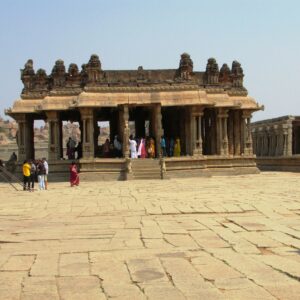
Vijaya Vittala Temple
Vijaya Vittala Temple
It’s a sprawling spectacle with pillared pavilions and shrines. The temple itself appears like a huge town!
King’s Balance
According to history, the king’s balance weighed the king’s weight with jewelry, precious stones, and other wealth. Next, the priests of the temples enjoyed the possession of weighed items.
5 meters tall and indeed a stone carved structure has three loops on the beam.
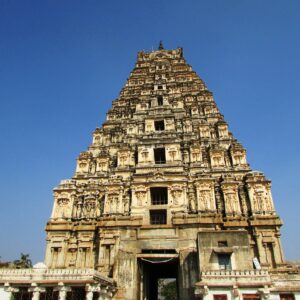
The Virupaksha Temple
The Virupaksha Temple
The Virupaksha Temple is the oldest, including everyone. Also named as Pampavati temple which is a reference to Shiva’s wife, Pampa.
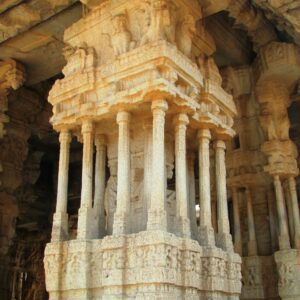
The Musical Pillars
The Musical Pillars
The Musical Pillars, when tapped at the appropriate places resonate music. Also called as SAREGAMA pillars, makes it not only a place of worship but also a place of art.
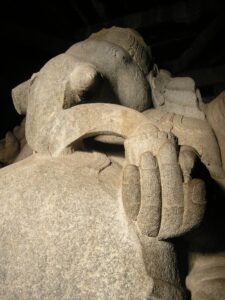
Ganesha Statue
Sasivikallu Ganesha Statue
A story from Hindu mythology about Lord Ganesha is prominent wherein he ties his stomach with a snake. The unique design narrates the exact same story.
After stuffing himself with so much food that led to his stomach on the brink of bursting, Lord Ganesha tied it with a snake.
The Royal Enclosure
As the name suggests this place solely rested for royals. According to the statistics, spread over a range of 59,000 square meters it can hold 43 houses at once.
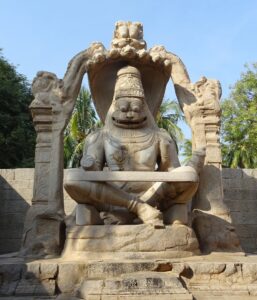
The statue of Narsimha
The statue of Narsimha
22 feet tall statue carved with magnificent details is a man-lion incarnation of Lord Vishnu.
Other structure include

Stepped tank
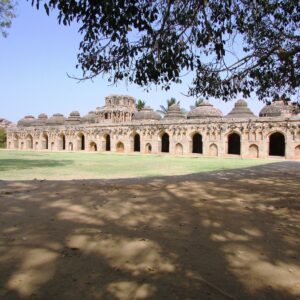
Elephants Stable
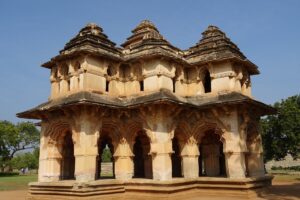
Lotus Mahal
Indian historical stories
Is Hampi its original name?
No, Hampi had a name before- it’s Pampakshetra.
Pampakshetra, the land of Pampa. Pampa denotes goddess Parvati. Facts in Hindu mythology state that the goddess Parvati sat in the posture of Yogini in the Hemkunta hills of Hampi. She led the life of yogini in order to convince Shiva to marry her.
So the river that flowed down the hill thereafter named, Pampa. The entire land is hence named, Pampa-Kshetra.

Tungabhadra river
The river is none other than, Tungabhadra which holds a great tourist attraction at present.
Hampi is the anglicized version of Pampa and pronounced Pampe in Kannada.
An icon of love?
Parvati fell in love with Lord Shiva. Shiva as always lost in meditation and driven to live an ascetic life had no knowledge.
Kama, the lord of lust shot an arrow of desire at Shiva but failed it. Everyone told Parvati that being in love with Shiva is hopeless as well as pointless. But determined Parvati adopted the life of yogini and won Shiva’s heart to bring him back to regular life.
Nevertheless, the whole of Hemkunta hill surrounds by temples dedicated to Lord Shiva and Goddess Parvati. Hence, it’s an icon of love…
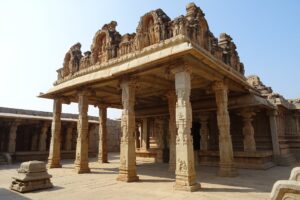
Hazara Rama Temple
Relation to Ramayana
Hampi is religiously sacred for Hindus for a number of reasons.
Let us place Shiva-Parvati and also Pampakshetra aside. Similarly, the story of Ramayana holds its importance in Hampi. In Ramayana, the mentioned monkey kingdom, Kiskinda stands to be Hampi.
It’s the place where Lord Rama met his loyal follower as well his friend, Lord Hanuman.

In North Hampi, a magnificent temple devoted to Lord Hanuman still stands in its full glory.
Scattered rocks and boulders
Once you start the bumpy bus journey to the site, the first things that meet your eyes are rocks and boulders! Simply scattered wherever your vision lands.

So why are they scattered like that?
Let us summarise it from two perspectives. Firstly, the Hindu mythological perspective, and secondly, the geological perspective.
According to Hindu mythology, in the epic Ramayana, the two monkey kings fought for their right over Kiskinda. The scattering of rocks is therefore marked as a result of the ferocious fight that took place between them.
Now, according to geology, Hampi falls in the region of Dharwar Craton. A craton falls under the list of areas that remain unchanged by tectonic movements.
Scattered rocks are years of erosion right from the prehistoric ages. By age, it counts billions of years!
A world heritage spot
In 2019, The New York Times released a list of 52 must-visit places in the entire world. And you know which place got the second position? – It’s Hampi!
Cultural harmony
The culture of India is rich beyond its borders.
Indian culture has forever been a mix of multiple cultures. In spite of being a Hindu dynasty, Hampi witnessed a number of cultural variations.
Multi-culture is an outcome of a multi-religious and multi-ethnic society!
Most of the monuments trace back to Hindu culture in the same way, there are 6 Jain temples too.
In the Eastern part of Hampi, there are also several Muslim structures. This includes 2 magnificent tombs which belong to Muslim nobles from the city.
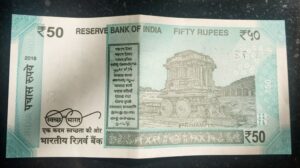
The secret on Rs. 50 note
Hampi holds major importance in India. It screams its importance as it holds a place behind India’s 50 rupee note. Thus declaring that India’s history is NOTEWORTHY!
How and who destroyed Hampi?
A glorious empire of 200 years faced utter destruction by the invaders in 1565. The Deccan Sultanate along with a few other alliances destroyed the city and looted it entirely within the course of 6 months.
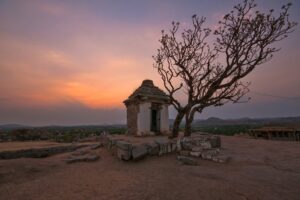
Conclusion
Facts and statistics about Hampi stated in the article show how magnificent India’s history is! But along with beauty, the most disturbing fact is, vandalizing of many of the structures at Hampi. It’s ugly and difficult to understand why people find a need to write their names on beautiful cultural pieces or destroy them.
Maybe it's ignorance or lack of education but actions like these are going to be an end of a great culture!


